
Spring arrives in March* every year and most would agree that it’s a relief to leave winter behind! All the signs are that it’s gradually beginning to get warmer. Plants and animals know this too. So, as the new season progresses, more and more of them can be seen by those who venture outdoors. From sprouting snowdrops, crocuses, and daffodils to the reappearance of bumblebees, butterflies, and migrating birds, the signs of spring are there for those who look. With that in mind, today’s post is a Spring Nature Hunt Activity for children to take part in. With it comes our nature hunt reference poster, which is part of a series that’s all free to download. Why not print it out for your children and encourage them, under supervision, to get outdoors and enjoy the spring sunshine? See how many of the 20 wonderful signs of spring they can spot! This activity will be a fun adventure that not only opens children’s eyes to the natural world but also gives them access to the profound benefits of spending time in nature. Nature is incredibly good for children and adults alike, so this is a wonderful opportunity for discovery, greater well-being, personal development and an antidote to the season we’re leaving behind. Step into spring with your little ones today and enjoy!
*When is the First Day of Spring?
There is often confusion over when, exactly, the season of spring begins. This is not surprising given that there are 2 official definitions of the first day of spring for those of us in the Northern Hemisphere:
- Using the meteorological calendar, spring begins on the first day of March and ends on the last day of May — simple! However, most of us more commonly recognise the second definition, which we explain below.
- Using the astronomical calendar, spring begins on the spring or ‘vernal’ equinox. That is the first day of the year in which both the day and night are of equal length, i.e. 12 hours each. The date of this event is not always the same each year as it all hinges on the position and tilt of the planet in its orbit around the sun. For 2025, the spring equinox — and therefore the first day of spring according to the astronomical calendar — begins on the 20th of March.
Your Free Spring Nature Hunt Reference Poster
Left- or right-click the preview image below to view or download in high-resolution PDF format. We suggest printing it out in colour with the highest quality paper and settings for the best results. The PDF can be printed as large as A3 or reduced to A4 or A5 if preferred. Once printed out, perhaps allow children to take a copy as a reference on outdoor trips, or display it on their bedroom wall.
More Free Nature Posters for Children
Don’t forget: today’s Spring Nature Hunt poster is one of a series of free nature-based posters and reference sheets available for children on this website. Others in the series include a Winter Nature Hunt, an Autumn Nature Hunt, a Leaves Nature Hunt, British Butterflies, British Birds, Wild Mammals, and Minibeasts. Come back regularly as we’ll add more in the coming months.

Getting Closer to Nature at Little Cedars Nursery, Streatham

 Children at Little Cedars Nursery in Streatham have ample opportunities to get close to nature. Our early years practitioners ensure they have regular access to enjoy and learn from the natural world— we know how important it is for them. The nursery/preschool is located close to the natural open spaces of Tooting Common and has its own planting area for children to enjoy. There, children look after seedlings and plants and even grow their own vegetables, which they can harvest when ready. Children instinctively love being close to nature as it’s fun, adventurous, character-building and educational. What’s more, it teaches them new skills, more about the world, where food originates, and the importance of taking responsibility for other living things. These are huge life lessons that illuminate the circle of life and a little more about their place in the world.
Children at Little Cedars Nursery in Streatham have ample opportunities to get close to nature. Our early years practitioners ensure they have regular access to enjoy and learn from the natural world— we know how important it is for them. The nursery/preschool is located close to the natural open spaces of Tooting Common and has its own planting area for children to enjoy. There, children look after seedlings and plants and even grow their own vegetables, which they can harvest when ready. Children instinctively love being close to nature as it’s fun, adventurous, character-building and educational. What’s more, it teaches them new skills, more about the world, where food originates, and the importance of taking responsibility for other living things. These are huge life lessons that illuminate the circle of life and a little more about their place in the world.
If you have a baby, toddler, or preschool child under five, why not explore a place for them at Little Cedars Nursery — we’d love to hear from you!
Little Cedars is a wonderful nursery in Streatham, London SW16. Ofsted rates the setting as a Good Provider in all categories, so you can be sure your child will be safe, well cared for and nurtured by professionals who have their best interests in mind. As well as serving those in Streatham, Streatham Hill and Streatham Common, Little Cedars Nursery may also suit families from Tooting, Furzedown, Balham, Norbury and Colliers Wood.
Outdoor Safety For Kids
Children, especially the young, require appropriate adult supervision and vigilance at all times when playing and exploring outdoors. For more information about the safety of children outdoors, check out our Top Tips for Outdoor Safety for Kids.


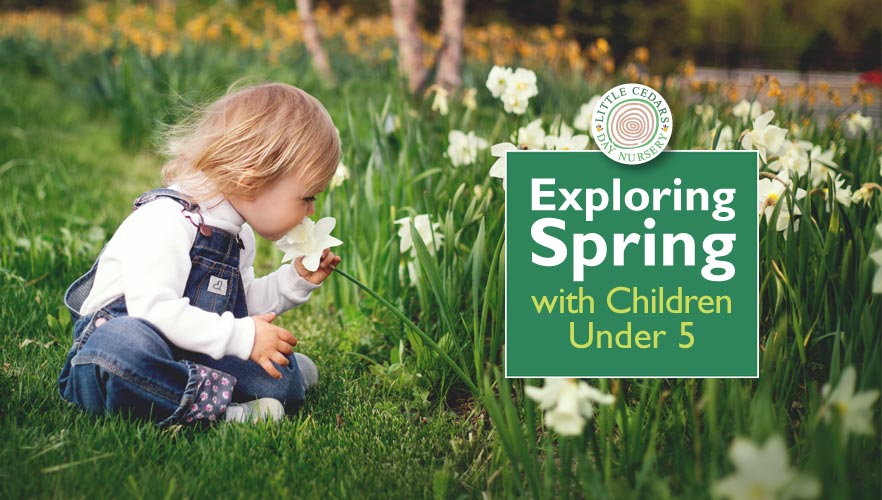
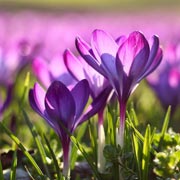 At Little Cedars Nursery, Streatham, one of the activities we do with children around this time of year is to explore the season of spring. Spring is a wonderful antidote to the cold, winter months as new shoots begin to sprout from the soil, flowers start to reappear, birds begin to return from warmer climes and there are early indications of warmer weather ahead. Paying attention to such things when spring arrives can teach children a great deal about the world around them, nature, and the impact of the various seasons. It’s also a free, fascinating, and educational activity that parents/guardians can do with children. Families can, for example, explore the signs of spring in the garden, out on walks, in local parks, and in the countryside. With that in mind, today’s article looks at the type of things children and families can look out for during the season of spring.
At Little Cedars Nursery, Streatham, one of the activities we do with children around this time of year is to explore the season of spring. Spring is a wonderful antidote to the cold, winter months as new shoots begin to sprout from the soil, flowers start to reappear, birds begin to return from warmer climes and there are early indications of warmer weather ahead. Paying attention to such things when spring arrives can teach children a great deal about the world around them, nature, and the impact of the various seasons. It’s also a free, fascinating, and educational activity that parents/guardians can do with children. Families can, for example, explore the signs of spring in the garden, out on walks, in local parks, and in the countryside. With that in mind, today’s article looks at the type of things children and families can look out for during the season of spring. As every child knows, young lambs are an absolute delight. They’re incredibly cute and the way they play, group together with fellow lambs, and happily jump into the air is simply adorable! Although timing varies from farm to farm, most newborn lambs arrive during early spring — typically in March — with others arriving in April, particularly if they’re in UK areas further north where it can be colder. At Little Cedars Nursery, we try to ensure children get to meet some spring lambs or calves each year and it’s always a huge hit with the children.
As every child knows, young lambs are an absolute delight. They’re incredibly cute and the way they play, group together with fellow lambs, and happily jump into the air is simply adorable! Although timing varies from farm to farm, most newborn lambs arrive during early spring — typically in March — with others arriving in April, particularly if they’re in UK areas further north where it can be colder. At Little Cedars Nursery, we try to ensure children get to meet some spring lambs or calves each year and it’s always a huge hit with the children.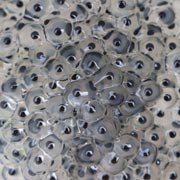 Another huge hit with children in spring is the appearance of frogspawn in ponds. Children will love watching the little eggs change over time, their contents growing from tiny black dots into creatures that have obvious legs, tails and heads. And, once they emerge from the eggs, the tadpoles continue to delight little ones as they gradually develop into tiny frogs. It’s a wonderfully magical thing for children to witness in spring and is also hugely educational.
Another huge hit with children in spring is the appearance of frogspawn in ponds. Children will love watching the little eggs change over time, their contents growing from tiny black dots into creatures that have obvious legs, tails and heads. And, once they emerge from the eggs, the tadpoles continue to delight little ones as they gradually develop into tiny frogs. It’s a wonderfully magical thing for children to witness in spring and is also hugely educational.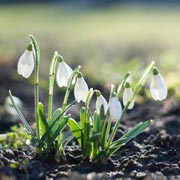 Snowdrops are one of the very first plants to reappear when spring arrives. They’re pretty little plants with slender green leaves and flowers that, as their name suggests, resemble delicate drops of snow. Young children will love that! Look out for them in gardens, parks, forests and hedgerows. Each plant generally forms a ‘bunch’ of around ten stems and they reappear every year. Warn children to look but not touch, though, as they are poisonous if eaten.
Snowdrops are one of the very first plants to reappear when spring arrives. They’re pretty little plants with slender green leaves and flowers that, as their name suggests, resemble delicate drops of snow. Young children will love that! Look out for them in gardens, parks, forests and hedgerows. Each plant generally forms a ‘bunch’ of around ten stems and they reappear every year. Warn children to look but not touch, though, as they are poisonous if eaten.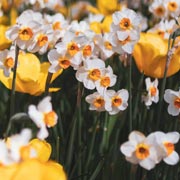 Another of the earliest plants to appear in the year is daffodils. Their shoots begin to appear through the soil in February and, once spring arrives in March, their flowers will brighten up any garden, lawn, forest or flower bed right into May. Once daffodils are in bloom, you also know other plants will soon follow. So, they’re a great sign of the changing season for children to look out for, and a signal that gloomy winter is now over and summer is not far away.
Another of the earliest plants to appear in the year is daffodils. Their shoots begin to appear through the soil in February and, once spring arrives in March, their flowers will brighten up any garden, lawn, forest or flower bed right into May. Once daffodils are in bloom, you also know other plants will soon follow. So, they’re a great sign of the changing season for children to look out for, and a signal that gloomy winter is now over and summer is not far away.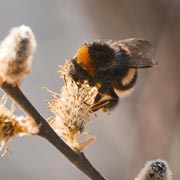 Bumblebees are amongst the cutest of garden visitors and many children will naturally love them, particularly once they’ve realised how adorable they are with their velvety bodies, sweet faces and attractive markings. They’re also peaceful little creatures, many of whom don’t even have a sting, who simply want to go about their business of collecting nectar from flowers. Bumblebees start to reappear in the spring — because flowers are also reappearing after being dormant over the winter months. They then become more and more populous as the months become warmer and can be seen right into autumn.
Bumblebees are amongst the cutest of garden visitors and many children will naturally love them, particularly once they’ve realised how adorable they are with their velvety bodies, sweet faces and attractive markings. They’re also peaceful little creatures, many of whom don’t even have a sting, who simply want to go about their business of collecting nectar from flowers. Bumblebees start to reappear in the spring — because flowers are also reappearing after being dormant over the winter months. They then become more and more populous as the months become warmer and can be seen right into autumn.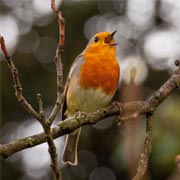 The return of many of the UK’s favourite birds is another wonderful sign that spring has arrived and winter is over. While some birds, including robins, may stay during winter, others will have migrated to warmer places, perhaps thousands of miles away. Once they return to the UK, children will be able to watch out for them and listen out for more birdsong. Early mornings and sunsets are great times to hear them, particularly when the weather is calm, meaning their sounds travel more clearly. For example, tiny wrens have an incredible and very melodic set of sounds. Robins are also beautiful to listen to. Thrushes sometimes sing at the tops of trees at dusk too, and that’s also wonderful to hear. Encourage children to watch and listen out for other birds too, for example, blackbirds, starlings, doves, blue tits, great tits and occasionally more rarely-seen birds like goldcrests.
The return of many of the UK’s favourite birds is another wonderful sign that spring has arrived and winter is over. While some birds, including robins, may stay during winter, others will have migrated to warmer places, perhaps thousands of miles away. Once they return to the UK, children will be able to watch out for them and listen out for more birdsong. Early mornings and sunsets are great times to hear them, particularly when the weather is calm, meaning their sounds travel more clearly. For example, tiny wrens have an incredible and very melodic set of sounds. Robins are also beautiful to listen to. Thrushes sometimes sing at the tops of trees at dusk too, and that’s also wonderful to hear. Encourage children to watch and listen out for other birds too, for example, blackbirds, starlings, doves, blue tits, great tits and occasionally more rarely-seen birds like goldcrests. Buds on trees and bushes can also be an interesting natural phenomenon for children to look out for in spring. Many are quite beautiful if you take the time to have a close look. Young children are indeed fascinated by several types of tree buds in early spring and perhaps the most attractive one to them is pussy willow. For them, the soft, fur-like buds of the pussy willow are an instant hit and something that really draws their attention. They really do feel furry and it’s almost as if they’re little creatures or kittens paws — quite a magical thing for any child to look out for in spring!
Buds on trees and bushes can also be an interesting natural phenomenon for children to look out for in spring. Many are quite beautiful if you take the time to have a close look. Young children are indeed fascinated by several types of tree buds in early spring and perhaps the most attractive one to them is pussy willow. For them, the soft, fur-like buds of the pussy willow are an instant hit and something that really draws their attention. They really do feel furry and it’s almost as if they’re little creatures or kittens paws — quite a magical thing for any child to look out for in spring!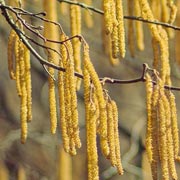 Catkins are also fascinating. Their little dangling fronds almost look like yellow caterpillars, so this is another type of spring occurrence to draw children’s attention to. From such attention, they can be taught lessons about pollen, seeds, nectar and the circle of life.
Catkins are also fascinating. Their little dangling fronds almost look like yellow caterpillars, so this is another type of spring occurrence to draw children’s attention to. From such attention, they can be taught lessons about pollen, seeds, nectar and the circle of life.